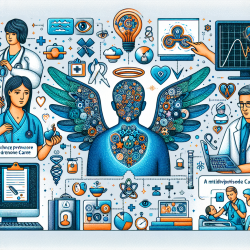Introduction
In the ever-evolving field of speech-language pathology, staying informed about the latest research is crucial for practitioners striving to deliver the best outcomes for children. A recent study titled "RARS1-related developmental and epileptic encephalopathy" offers valuable insights into a rare genetic condition that affects the central nervous system. This blog will explore the study's findings and discuss how practitioners can leverage this knowledge to enhance their therapeutic approaches.
Understanding RARS1-Related Developmental and Epileptic Encephalopathy
The study conducted by Wan et al. (2023) investigates the impact of biallelic variants in the RARS1 gene, which encodes the cytoplasmic tRNA synthetase for arginine (ArgRS). These genetic mutations are linked to central nervous system manifestations, including hypomyelinating leukodystrophy and developmental and epileptic encephalopathy (DEE). The research identified two patients with these mutations and reviewed literature involving 27 additional patients.
Key findings from the study include:
- Patients with RARS1 mutations frequently exhibit DEE, a severe phenotype, along with hypomyelinating leukodystrophy.
- Common symptoms among the 29 patients studied include intellectual disability, developmental delay, and hypomyelination.
- The mutations also influence cortical development, affecting the expression and stability of the ArgRS protein.
Implications for Practitioners
For practitioners in the field of speech-language pathology, understanding the genetic underpinnings of conditions like RARS1-related DEE can inform more targeted and effective interventions. Here are some ways practitioners can apply this knowledge:
- Personalized Therapy Plans: Recognizing the specific genetic mutations and their impact on neurological development allows practitioners to tailor therapy plans to address the unique needs of each child.
- Interdisciplinary Collaboration: Collaborating with geneticists and neurologists can provide a comprehensive understanding of the child's condition, leading to more holistic care.
- Family Education and Support: Educating families about the genetic aspects of their child's condition can empower them to make informed decisions and actively participate in the therapeutic process.
Encouraging Further Research
While the study provides significant insights, it also highlights the need for further research into the mechanisms of RARS1-related disorders. Practitioners are encouraged to stay engaged with ongoing research and consider participating in studies that aim to expand our understanding of these complex conditions.
Conclusion
By integrating the findings from the RARS1-related developmental and epileptic encephalopathy study into their practice, speech-language pathologists can enhance their therapeutic approaches and contribute to improved outcomes for children. Continued research and collaboration across disciplines will be key to unlocking the full potential of these insights.
To read the original research paper, please follow this link: RARS1-related developmental and epileptic encephalopathy.










